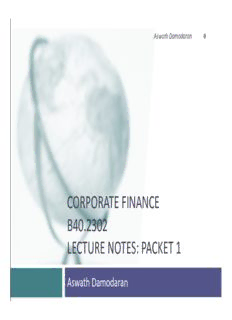Table Of ContentAswath Damodaran 0
CORPORATE FINANCE
B40.2302
LECTURE NOTES: PACKET 1
Aswath Damodaran
Aswath Damodaran 1
THE OBJECTIVE IN CORPORATE
FINANCE
“ ’
If you don t know where you are going, it does’nt
”
matter how you get there
First Principles
2
Maximize the value of the business (firm)
The Investment Decision The Dividend Decision
The Financing Decision
Invest in assets that earn a If you cannot find investments
Find the right kind of debt
return greater than the that make your minimum
for your firm and the right
minimum acceptable hurdle acceptable rate, return the cash
mix of debt and equity to
rate to owners of your business
fund your operations
The hurdle rate The return How much How you choose
The optimal The right kind
should reflect the should reflect the cash you can to return cash to
mix of debt of debt
riskiness of the magnitude and return the owners will
and equity matches the
investment and the timing of the depends upon depend on
maximizes firm tenor of your
the mix of debt cashflows as well current & whether they
value assets
and equity used as all side effects. potential prefer dividends
to fund it. investment or buybacks
opportunities
Aswath Damodaran
2
The Objective in Decision Making
3
In traditional corporate finance, the objective in decision making is to
¨
maximize the value of the firm.
A narrower objective is to maximize stockholder wealth. When the stock
¨
is traded and markets are viewed to be efficient, the objective is to
maximize the stock price.
Maximize equity
Maximize market
Maximize
value
estimate of equity
firm value
value
Assets Liabilities
Existing Investments Fixed Claim on cash flows
Assets in Place Debt
Generate cashflows today Little or No role in management
Includes long lived (fixed) and Fixed Maturity
short-lived(working Tax Deductible
capital) assets
Expected Value that will be Growth Assets Equity Residual Claim on cash flows
created by future investments Significant Role in management
Perpetual Lives
Aswath Damodaran
3
“ ”
Maximizing Stock Prices is too narrow an
objective: A preliminary response
4
Maximizing stock price is not incompatible with
¨
meeting employee needs/objectives. In particular:
Employees are often stockholders in many firms
¤
Firms that maximize stock price generally are profitable
¤
firms that can afford to treat employees well.
Maximizing stock price does not mean that
¨
customers are not critical to success. In most
businesses, keeping customers happy is the route to
stock price maximization.
Maximizing stock price does not imply that a
¨
company has to be a social outlaw.
Aswath Damodaran
4
Why traditional corporate financial theory
focuses on maximizing stockholder wealth.
5
Stock price is easily observable and constantly updated
¨
(unlike other measures of performance, which may not
be as easily observable, and certainly not updated as
frequently).
If investors are rational (are they?), stock prices reflect
¨
the wisdom of decisions, short term and long term,
instantaneously.
The objective of stock price performance provides some
¨
very elegant theory on:
Allocating resources across scarce uses (which investments to
¤
take and which ones to reject)
how to finance these investments
¤
how much to pay in dividends
¤
Aswath Damodaran
5
The Classical Objective Function
6
STOCKHOLDERS
Maximize
Hire & fire
stockholder
managers
wealth
- Board
- Annual Meeting
No Social Costs
Lend Money
Managers
BONDHOLDERS/ SOCIETY
LENDERS Protect
All costs can be
bondholder
traced to firm
Interests
Reveal Markets are
information efficient and
honestly and assess effect on
on time value
FINANCIAL MARKETS
Aswath Damodaran
6
What can go wrong?
7
STOCKHOLDERS
Managers put
Have little control
their interests
over managers
above stockholders
Significant Social Costs
Lend Money
Managers
BONDHOLDERS SOCIETY
Bondholders can
Some costs cannot be
get ripped off
traced to firm
Delay bad
news or Markets make
provide mistakes and
misleading can over react
information
FINANCIAL MARKETS
Aswath Damodaran
7
I. Stockholder Interests vs. Management
Interests
8
In theory: The stockholders have significant control over
¨
management. The two mechanisms for disciplining
management are the annual meeting and the board of
directors. Specifically, we assume that
Stockholders who are dissatisfied with managers can not only
¤
express their disapproval at the annual meeting, but can use
their voting power at the meeting to keep managers in check.
The board of directors plays its true role of representing
¤
stockholders and acting as a check on management.
In Practice: Neither mechanism is as effective in
¨
disciplining management as theory posits.
Aswath Damodaran
8
The Annual Meeting as a disciplinary venue
9
The power of stockholders to act at annual meetings is
¨
diluted by three factors
Most small stockholders do not go to meetings because the cost
¤
of going to the meeting exceeds the value of their holdings.
Incumbent management starts off with a clear advantage when
¤
it comes to the exercise of proxies. Proxies that are not voted
becomes votes for incumbent management.
For large stockholders, the path of least resistance, when
¤
confronted by managers that they do not like, is to vote with
their feet.
Annual meetings are also tightly scripted and controlled
¨
events, making it difficult for outsiders and rebels to
bring up issues that are not to the management’s liking.
Aswath Damodaran
9

